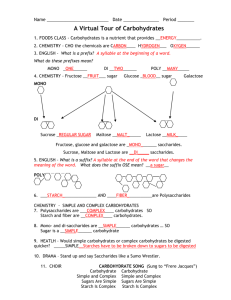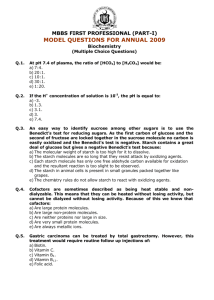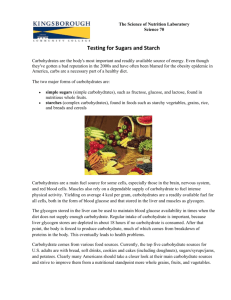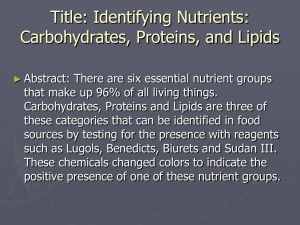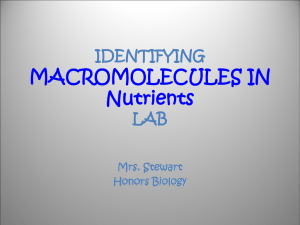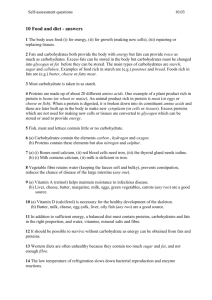Laboratory 26: Carbohydrates Introduction Discussion
advertisement
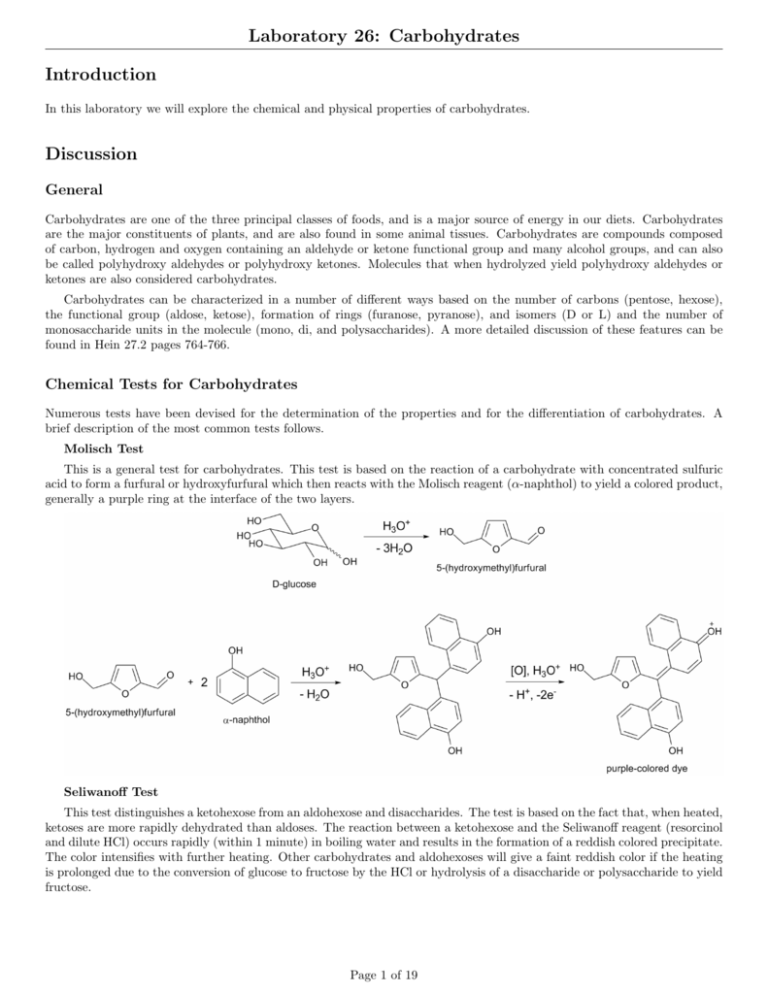
Laboratory 26: Carbohydrates Introduction In this laboratory we will explore the chemical and physical properties of carbohydrates. Discussion General Carbohydrates are one of the three principal classes of foods, and is a major source of energy in our diets. Carbohydrates are the major constituents of plants, and are also found in some animal tissues. Carbohydrates are compounds composed of carbon, hydrogen and oxygen containing an aldehyde or ketone functional group and many alcohol groups, and can also be called polyhydroxy aldehydes or polyhydroxy ketones. Molecules that when hydrolyzed yield polyhydroxy aldehydes or ketones are also considered carbohydrates. Carbohydrates can be characterized in a number of different ways based on the number of carbons (pentose, hexose), the functional group (aldose, ketose), formation of rings (furanose, pyranose), and isomers (D or L) and the number of monosaccharide units in the molecule (mono, di, and polysaccharides). A more detailed discussion of these features can be found in Hein 27.2 pages 764-766. Chemical Tests for Carbohydrates Numerous tests have been devised for the determination of the properties and for the differentiation of carbohydrates. A brief description of the most common tests follows. Molisch Test This is a general test for carbohydrates. This test is based on the reaction of a carbohydrate with concentrated sulfuric acid to form a furfural or hydroxyfurfural which then reacts with the Molisch reagent (α-naphthol) to yield a colored product, generally a purple ring at the interface of the two layers. Seliwanoff Test This test distinguishes a ketohexose from an aldohexose and disaccharides. The test is based on the fact that, when heated, ketoses are more rapidly dehydrated than aldoses. The reaction between a ketohexose and the Seliwanoff reagent (resorcinol and dilute HCl) occurs rapidly (within 1 minute) in boiling water and results in the formation of a reddish colored precipitate. The color intensifies with further heating. Other carbohydrates and aldohexoses will give a faint reddish color if the heating is prolonged due to the conversion of glucose to fructose by the HCl or hydrolysis of a disaccharide or polysaccharide to yield fructose. Page 1 of 19 Laboratory 26: Carbohydrates Benedicts Test This tests for reducing sugars. Free aldehyde groups, α-hydroxy ketones and hemiacetals are capable of reducing metal ions in solution. All common monosaccharides are reducing sugars. Some easily hydrolyzed disaccharides and polysaccharides will give a positive test, while harder to hydrolyze di- and poly sacchrides may initially be nonreducing, but react after extended time or upon heating in acidic solution by being hydrolyzed to monosaccharides. In the Benedicts test Cu +2 ions (blue in solution) are reduced to Cu +1 ions that form Cu2 O which is a brick-red precipitate. Depending on the amount of precipitate produced, a positive Benedicts test can appear green, yellow, orange, or red. For more information see Hein. Barfoeds Test The Barfoeds test is similar to the Benedicts test, but differs in the specific reagents used (copper (II) acetate and acetic acid) which is less reactive than the Benedicts reagent. It is used to differentiate between monosaccharides and disaccharides. When boiled in water, monosaccharides will react in under five minutes, while disaccharides will take longer. If heated long enough (10-15 minutes) disaccharides will give a positive result due to hydrolysis to form monosaccharides. As in the Benedicts test above, the primary reaction is the reduction of Cu +2 ions to Cu2 O which forms a brick red precipitate. Bial Test This test is used to distinguish between pentoses and hexoses. The Bial reagent contains orcinol (5-methyl rescorcinol) dissolved in concentrated HCl with a small amount of iron (III) chloride present. When mixed with a monosaccharide, pentoses are converted to a furfural to yield a blue-green product. Hexoses, with prolonged heating, yield a muddy red precipitate. Iodine Test Iodine reacts with polysaccharides to give colored complexes. Specifically amylose gives a deep blue-black color, amylopectin, cellulose, form red to brown colors, and glycogen produces a reddish colored precipitate. Monosaccharides and Disaccharides are two small to trap the iodine molecules and do not form dark colored complexes. The iodine test can be used to distinguish between mono/disaccharides and polysaccharides. It may also be used to follow the course of a hydrolysis reaction. Page 2 of 19 Laboratory 26: Carbohydrates Procedure A. Molisch Test 1. Place 5 mL of each solution to be tested in a test tube. 2. Add 3 drops of the Molisch reagent. Swirl to mix. 3. Tilt the test tube at a 45 degree angle and carefully add 40 drops of concentrated sulfuric acid by slowly dripping it down the side of the test tube. Do NOT mix the solutions. The sulfuric acid should form a layer beneath the carbohydrate layer. 4. Set the test tubes carefully in the rack and observe for evidence of a reaction over the next 15-20 minutes. Record your results. 5. Dispose of the contents of the test tubes in the waste bottle labeled ”E26 Carbohydrate Waste”. B. Seliwanoff Test 1. Place 1 mL of each solution to be tested in a test tube. 2. Add 4 mL of the Seliwanoff reagent. Swirl to mix. 3. Place the test tubes in a boiling water bath for 2-3 minutes. Do not overheat. 4. Record your results. 5. Dispose of the contents of the test tubes in the waste bottle labeled ”E26 Carbohydrate Waste”. C. Benedict Test 1. Place 1 mL of each solution to be tested in a test tube. 2. Add 5 mL of the Benedicts reagent. Swirl to mix. 3. Place the test tubes in a boiling water bath for 5 minutes. Do not overheat. 4. Record your results. 5. Dispose of the contents of the test tubes in the waste bottle labeled ”E26 Carbohydrate Waste”. D. Barfoed Test 1. Place 1 mL of each solution to be tested in a test tube. 2. Add 5 mL of the Barfoed reagent. Swirl to mix. 3. Place the test tubes in a boiling water bath for 5 minutes. Do not overheat. 4. Record your results. 5. Dispose of the contents of the test tubes in the waste bottle labeled ”E26 Carbohydrate Waste”. E. Bial Test 1. Place 2 mL of each solution to be tested in a test tube. 2. Carefully add 3 mL of the Bials reagent. (Bials reagent is dissolved in concentrated HCl. Swirl to mix. 3. Carefully heat (with agitation) each tube over a bunsen burner until the mixture just begins to boil. 4. Record your results. 5. Dispose of the contents of the test tubes in the waste bottle labeled ”E26 Carbohydrate Waste”. Page 3 of 19 Laboratory 26: Carbohydrates F. Iodine Test 1. Place 2 mL of each solution to be tested in a test tube. 2. Add 2-3 drops of the Iodine reagent. Swirl to mix. 3. Record your results. 4. Dispose of the contents of the test tubes in the waste bottle labeled ”E26 Carbohydrate Waste”. G. Hydrolysis of Disaccharides 1. Perform the Benedict and Seliwanoff test prior to doing this section. 2. Place 10 mL of disaccharide in a test tube. 3. Add 5 drops of concentrated HCl to the test tube. 4. Place the test tubes in boiling water for 10 minutes. 5. Cool the solutions. 6. Neutralize the acid with 10% NaOH solution (15-20 drops), using red litmus paper as an indicator. 7. Using 2 mL portions of the resulting solutions run the Benedict and Seliwanoff tests. 8. Record your results. 9. Dispose of the contents of the test tubes in the waste bottle labeled ”E26 Carbohydrate Waste”. H. Hydrolysis of a Polysaccharide 1. Perform the Iodine and Benedict test prior to doing this section. 2. In a 250 mL beaker place 2.5 mL of a 1% starch solution, 200 mL of water, and 10 drops of concentrated hydrochloric acid. 3. Remove a 2-3 mL portion of the sample. Perform the Iodine test on the removed sample. Record your results. 4. Cover the beaker with a watch glass, and gently boil the starch solution for 15-30 minutes. Consider time zero to be when the solution first boils. 5. After the solution starts to boil, remove 2-3 mL of the solution and perform the Iodine test. Record your results. 6. Perform the iodine test every 5 minutes until a clear results is achieved. Record your results. 7. If your solution is running dry, add 50 mL of water to the beaker. 8. After the heating is completed, take a 2-3 mL portion and neutralize it with 10% NaOH solution, using red litmus paper as an indicator. 9. Perform the Benedict test on the sample. 10. Record your results. 11. Dispose of the contents of the test tubes in the waste bottle labeled ”E26 Carbohydrate Waste”. I. Fruit Juices 1. Perform the Benedict and Seliwanoff test prior to doing this section. 2. Using the fruit juice samples provided run the Benedict and Seliwanoff tests using 1 mL samples of each juice. 3. Dispose of the contents of the test tubes in the waste bottle labeled ”E26 Carbohydrate Waste”. Page 4 of 19 Laboratory 26: Carbohydrates Name: Class: Date: Results A-C. Characteristic Tests for Carbohydrates Molisch Seliwanoff Water Arabinose Glucose Fructose Maltose Sucrose Starch Xylose Page 5 of 19 Benedict Laboratory 26: Carbohydrates D-F. Characteristic Tests for Carbohydrates Barfoed Bial Water Arabinose Glucose Fructose Maltose Sucrose Starch Xylose Page 6 of 19 Iodine Laboratory 26: Carbohydrates G. Hydrolysis of a Disaccharide Sucrose Maltose Benedicts Seliwanoff Products of Hydrolysis Page 7 of 19 Laboratory 26: Carbohydrates H. Hydrolysis of Starch Control (H2 O) 0 min. 5 min. 10 min. 15 min. 20 min. 25 min. 30 min. 35 min. 40 min. 45 min. 50 min. 55 min. 60 min. Benedicts Draw a smiley face! Observation Observation Observation Observation Page 8 of 19 Laboratory 26: Carbohydrates I. Fruit Juices Fruit Juice ID Benedicts Seliwanoff Page 9 of 19 Laboratory 26: Carbohydrates Questions A. Molisch Test 1. Describe the evidence for a positive test. 2. What does a positive test indicate? 3. What is the chemical basis for a positive test? 4. Circle the names of the substances that gave a positive test. Water Arabinose Glucose Fructose Maltose Sucrose Starch 5. List any substances that gave a false positive result and/or a false negative result. Explain. Page 10 of 19 Xylose Laboratory 26: Carbohydrates B. Seliwanoff Test 6. Describe the evidence for a positive test. 7. What does a positive test indicate? 8. What is the chemical basis for a positive test? 9. Circle the names of the substances that gave a positive test. Water Arabinose Glucose Fructose Maltose Sucrose Starch Xylose 10. List any substances gave a false positive result and/or a false negative result. Explain. 11. Upon prolonged heating, would you expect any of the substances that gave a negative result to yield a positive result? Explain. Page 11 of 19 Laboratory 26: Carbohydrates C. Benedict 12. Describe the evidence for a positive test. 13. What does a positive test indicate? 14. What is the chemical basis for a positive test? 15. Circle the names of the substances that gave a positive test. Water Arabinose Glucose Fructose Maltose Sucrose Starch Xylose 16. List any substances gave a false positive result and/or a false negative result. Explain. 17. If the Cu +2 ions in the Benedicts Reagent are reduced what must have happened to the sugar? Explain. 18. Complete the following reaction. Assume that the carbohydrate forms a salt. Glucose + 2 Cu +2 + 5 OH – + Na+ −−→ Page 12 of 19 Laboratory 26: Carbohydrates D. Barfoed 19. Describe the evidence for a positive test. 20. What does a positive test indicate? 21. What is the chemical basis for a positive test? 22. Circle the names of the substances that gave a positive test. Water Arabinose Glucose Fructose Maltose Sucrose Starch 23. List any substances gave a false positive result and/or a false negative result. Explain. Page 13 of 19 Xylose Laboratory 26: Carbohydrates E. Bials 24. Describe the evidence for a positive test. 25. What does a positive test indicate? 26. What is the chemical basis for a positive test? 27. Circle the names of the substances that gave a positive test. Water Arabinose Glucose Fructose Maltose Sucrose Starch Xylose 28. List any substances gave a false positive result and/or a false negative result. Explain. 29. Write the structural formula AND name of two carbohydrates not tested that would give a positive Bial test. Page 14 of 19 Laboratory 26: Carbohydrates G. Hydrolysis of Disaccharides 30. What do the results of these tests indicate about the composition of sucrose and maltose? Explain. 31. Write a chemical reaction showing the hydrolysis of sucrose. H. Hydrolysis of Starch 32. Describe the evidence for a positive test. 33. What does a positive test indicate? 34. Why does the disappearance of the initial blue/black color observed indicate the starch was hydrolyzed while being heated? Explain. 35. What additional evidence did you observe to indicate that starch was hydrolyzed? Explain. Page 15 of 19 Laboratory 26: Carbohydrates I. Fruit Juices 36. Which carbohydrate(s) is proven to be present in each fruit juice? Explain. 37. Which fruit juice sample is really not a fruit juice? Explain. J. Additional Questions 38. The possible carbohydrates in the following problems are limited to: arabinose, glucose, fructose, maltose, sucrose, and starch. Identify the carbohydrate(s) in each sample below: (a) A carbohydrate solution gave a positive Molisch test and a negative Benedict, Barfoed, Bial, and Seliwanoff tests. When treated with HCl and boiled for several minutes, the solution showed a positive result for Benedict, Barfoed, and Seliwanoff tests, and a negative for Bials. What is the identity of the carbohydrate? Explain. (b) A solution containing only one carbohydrate gave a Cu2 O precipitate with the Benedict reagent. What possible carbohydrates are present in the solution? Explain. (More that one answer) (c) Using the solution in (b) the sample failed to give a Cu2 O precipitate with the Barfoed reagent. Of the carbohydrates possible in (b), which single carbohydrate must have been present? Explain. Page 16 of 19 Laboratory 26: Carbohydrates 39. Explain what results would be observed when lactose reacts with each of the following reagents: (i.e. Would a positive or negative result occur, and what visible evidence would be seen) (a) Benedict (b) Barfoed (c) Seliwanoff Page 17 of 19 Laboratory 26: Carbohydrates Name: Class: Date: Page 18 of 19 Laboratory 26: Carbohydrates Prelab Questions 1. Draw the structure of the following molecules and complete the table. Structure Aldose/Ketose Arabinose Glucose Fructose Maltose Sucrose Starch Xylose Page 19 of 19 Pentose/Hexose Mono/Di/Poly

